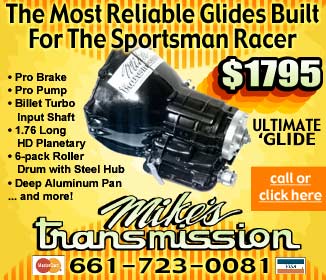|

QUESTION 1
Mike,
Let me start with saying I donít know squat about the inner workings of an automatic
transmission. I have a Ford bracket car that weighs in at 2800 lbs. with me in it. It is
powered by a 302 that makes roughly 400 hp. I used to foot brake it with a C-4 for years
with an affordable 10-inch converter with an advertised stall speed of 3500 rpms. This set
up worked great for me for years, but I wanted to leave off a trans brake, so I bought one.
First, the car rolls forward when the brake is applied while staging, causing reaction time
inconsistencies. Second, it flares between shifts.
I replaced the valve body once with negative results. The person assembling my
transmissions is competent, but has little performance background.
Any suggestions? Your help will be greatly appreciated. I am currently considering buying a
professional-built C-4 or perhaps even a powerglide, both with a brake.
Joe Moravec
Twin Lakes, Wisconsin
Joe,
A racing automatic transmission is a very
particular animal. If things arenít right, nothing
works. All of the systems have to be top-notch.
The C-4 especially is a problem-prone unit.
You really need to start from the bottom up.
Build it with some good packs, band, servo,
etc. And possibly a good brake too!
Mike Stewart
QUESTION 2
Hey Mike,
I have a question regarding torque converters. I always hear the terms "loose" or "tight,"
and "driving through the converter." What do they mean exactly? Does it have to do with
efficiency, converter size, torque multiplication, or slippage at top end?
When I ordered a cam for my engine, the cam manufacturer said I would need a tight 9-inch
or a loose 8-inch, but both with around 4500 stall. What would be the difference
performance-wise between the two? I know you want the converter loose to get a good 60-
foot time and tight enough so you donít buzz the engine through the traps, but what actually
affects whether the converter is going to be too tight or too loose?
I keep getting different opinions from people and would like to know the true answer from a
guy who knows. Thanks.
Mike Rozman
Mike,
The torque converter in a performance or
racing application is one of the most important
components in the car. To start with the basics,
we need to launch the car at peak torque in
a racing application. This is why dyno sheets,
etc. are so important. We need the converter
to slip pretty easily up to this point.
ADVERTISEMENT
 |
|
A trans brake can really help to hold the
car while we get the motor up against the converter.
We need a couple thousand rpm band to race in
the quarter-mile or even eighth-mile.
So, say peak torque is at 5000 rpm and peak
horsepower is at 7000 rpm. We launch at 5000,
shift at 6800-7000, and get enough gear in the
rear so we can run through the lights at 7000.
Drag racing is a test of acceleration. Lighter
parts are quicker. A smaller converter 8-inch
will react more quickly as long as it will hold
back the load at full throttle.
When someone says the converter is too tight,
they mean it will not let the engine get up
to the point where it starts making good power.
When someone says the converter is too loose,
the converter is letting the engine run up past
peak torque and wasting power through slippage.
Driving through the converter is also too loose
or the converter will not load the engine to
get all the power to the ground.
Like anything else, itís all in the combination.
Mike Stewart
<
MORE STORIES >
|